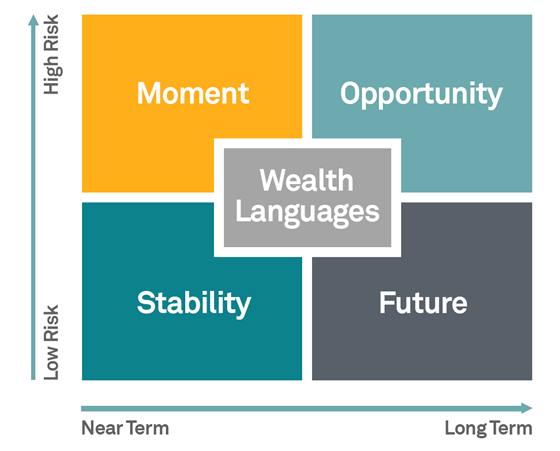\ ˈlan-ˌyap , lan-ˈyap \
: a small gift given to a customer by a merchant at the time of a purchase; broadly : something given or obtained gratuitously or by way of good measure

Saint Louis Cathedral, New Orleans; Pintrest
Wealth Languages
As a financial advisor, I'm constantly talking to people about money. Among the many topics are identifying and mitigating risk to clients' wealth. Financial advisors have many tools at their disposal to address these risks, but what if the biggest risk to wealth can't be solved with a finely tuned portfolio or a comprehensive financial plan? What if the largest risk to wealth has nothing to do with the use of money at all?
A recent study conducted by The Williams Group, surveyed 3,000 wealthy families and concluded that 70% of those families lost their wealth by the end of the second generation. By the third generation, an incredible 90% of the families' wealth had been lost.
Why was this happening? A follow-up study discovered that less than 5% of the wealth loss across generations was due to poor investment, legal issues, or tax problems. Instead, 95% of wealth loss was rooted in a breakdown of a family's communication and trust.
Perhaps one of the biggest risks to wealth is the inability to talk about money within the family dynamic.
To address this issue, a financial advisor named Cale Dowell, of Archetype Wealth Partners, has developed the Wealth Languages model to help individuals and families better understand how they view and communicate about money. He settled on four primary Wealth Languages which capture the intrinsic motivators that influence our communication about money:
Within these languages, there are two spectrums: time and risk. The languages can reflect the near to long term, and high to low risk. This graphic provides a good visual framework of the languages:

Perhaps the traits of these four different languages are obvious, even intuitive. I have plenty of additional material we can discuss when we meet, but even your initial impressions could be insightful. In fact, you may already have some idea as to which language represents how you think and communicate about money.
But here's the most important question: How does your spouse or family view their finances? Discussing this, and nearly any other facet of money, will help you better understand each other, improve your communication, and build trust. Then, you are on the path to maintaining, even building, your family’s generational wealth.
Interested in discussing this topic further? Make an appointment soon, and we can move forward in understanding your Wealth Language.
Laissez les bons temps rouler
Informed Investor
I’ve assembled a few recent articles that I found interesting and informative. I also added a little light diversion.
Mary's Recipe Corner
Enjoy one of my wife's all-time favorite recipes:
Lime Cheesecake Muffins
These are a favorite treat of our eldest daughter. You can just make the muffins, or add any or all of the three additions of crust, filling, and/or glaze. All four parts together make a truly tasty tart treat!
This recipe makes 2 dozen muffins.
Graham crust-
1-1/2 sleeves of graham crackers (2 cups of crumbs)
1/4 cup sugar
8 TBSP butter, melted
Filling-
8 oz cream cheese, softened
1/2 egg (whisk egg together and pour out half)
1/4 cup sugar
Zest and juice of 1 medium lime
Muffins-
4 cups flour
2 cup sugar
1 TBSP + 2 tsp baking powder
1 tsp salt
4 eggs
1/2 cup milk
2/3 cup oil
6 TBSP lime juice
1 TBSP lime zest
Glaze-
2 TBSP lime juice
1/2 cup sugar
1/2 cup sour cream or plain Greek yogurt
2 TBSP butter
Crust-
Place 24 liners in muffin tins. Combine crust ingredients. Place equal amounts of crumbs in each cup and tamp down.
Filling-
Mix well all the ingredients.
Muffins-
Combine dry ingredients. In a separate bowl, combine wet ingredients. Stir together. Place enough batter to cover the crust of each muffin. Use a small scoop to divide the filling in all the muffins. Cover with the filling with the rest of the batter. Bake 350, 17-20 min.
Glaze-
Combine all ingredients in a saucepan. Bring to a boil and continue boiling for 3 minutes. Strain if lumpy. Portion over warm muffins. Cool completely. Enjoy!
For Art's Sake
As some of you may know, I'm an art enthusiast. If you grow up in New Orleans you learn to appreciate art (and food and music and parades, etc.), so it seems appropriate to share a bit of our culture with our readers.
George Rodrigue (March 13, 1944 – December 14, 2013) was an American artist who in the late 1960s began painting Louisiana landscapes, followed soon after by outdoor family gatherings and southwest Louisiana 19th-century and early 20th-century genre scenes. His paintings often include moss-clad oak trees, which are common to an area of French Louisiana known as Acadiana. In the mid-1990s Rodrigue's Blue Dog paintings, based on a Cajun legend called Loup-garou, catapulted him to worldwide fame.

"Spring is Here AP 1996", by George Rodrigue